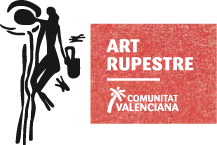Sites
Abric Centelles
Levantino - Albocàsser
Abric Centelles (Albocàsser, Castelló). A site located in the Serra del Pouet o Narrabes, consisting of a large shelter of almost 60 m discovered in 1982. The site offers a considerable number of figures, notably archers with slim forms in Levantine style. Also of note are diverse scenes of a social nature, such as a […]
Abrigo de Lucio
Levantino - Bicorp
Abrigo de Lucio (Bicorp, Valencia) is located in the central section of the Barranco Primero, which connects with the Barranco Moreno. The site consists of a very large shelter where diverse figures in Levantine and Schematic styles can be observed. Of particular note are a group of 3 feminine figures walking arm-in-arm, as well as […]
Abrigo de Voro
Esquemático - Quesa
Abrigo de Voro (Quesa, Valencia) is a large shelter located in the middle-to-lower stretch of the Río Grande, a tributary of the Río Escalona. It was discovered in 1972 by Salvador Gómez and Manuel Flores. More than a hundred motifs have been identified, in both Levantine style (archers, feminine figures, goats and deer…) and Schematic […]
Abrigo del Garrofero
Levantino - Navajas
El Abrigo del Garrofero (Navarrés, Valencia) was discovered in 1972 by a SIP commission in which Salvador Gómez, Manuel Flores and José Aparicio took part. The site is situated in the central stretch of the Río Grande and covers an area of approximately 23 m. Among the motifs documented there are human and animal figures […]
Balsa de Calicanto
Levantino - Bicorp
Balsa de Calicanto (Bicorp, Valencia) is situated in the Barranco Moreno. This is a large shelter with a considerable number of meandering pictorial motifs in Schematic Art, as well as various human figures. There are also two zoomorphic figures in Levantine style.
Cova de la Saltadora
Levantino - Coves De Vinromà, Les
Cova de la Saltadora (Coves de Vinromà, Castelló). Discovered in 1917 by Albert Roda i Segarra, it is situated on the left flank of the Barranc de la Valltorta. The site is composed of a set of shelters covering a stretch of some 200 m. More than 150 motifs survive, among which human and animal […]
Cova dels Cavalls
Levantino - Tirig
Cova dels Cavalls (Tírig, Castelló). The site is located in the central part of the Barranc de la Valltorta. Discovered in 1917 by Albert Roda i Segarra, it shows one of the best-known scenes from Levantine Art: a deer hunt whose figures are depicted with great naturalism, including a herd of ten deer and a […]
Cova Mas d’En Josep.
Levantino - Tirig
Cova Mas d’En Josep (Tírig, Castelló). Situated in the Barranc de la Valltorta, in an area with a great concentration of pictorial registers, the site presents hunting scenes in Levantine style across two panels, in which we can observe an archer hunting a wild boar (sector 1), and a group of deer pursued by some […]
Cova Remigia and Cingle de la Mola Remigia
Levantino - Ares del Maestre
Cova Remigia and Cingle de la Mola Remigia (Ares del Maestrat, Castelló). In 1934 these sites on the right flank of Barranc de la Gasulla were discovered. Modern studies identify as many as 1300 figures, including both isolated individuals and scenes such as boar-hunting or others related to hunting or the chase, in Levantine style. […]
Coves del Civil o dels Ribassals
Levantino - Tirig
Coves del Civil o dels Ribassals (Tírig, Castelló). Discovered in 1917, it is made up of a set of three shelters with Levantine representations, as well as some Schematic motifs. Shelter 2 offers one of the most representative Levantine depictions, a group of archers of different sizes and slender bodies, facing one another as in […]
Galeria Alta de la Masia
Levantino - Morella
Galeria Alta (Morella, Castelló). The representations in Levantine and Schematic styles are situated in a series of cavities in the Mola de Morella la Vella, and were discovered in 1917. They consist of small figures, notably some line drawings of human figures with circular heads.
Galeria del Roure
Levantino - Morella
Galeria del Roure (Morella, Castelló). This site has scenes of wild goat hunting, plus a scene of warfare. This well-known scene in Levantine style is a very dynamic image of 7 archers in confrontation, traced with line drawings.
La Sarga
Levantino - Alcoi/alcoy
The La Sarga site is situated at the head of the Barranc de la Foradà (mountainous terrain of La Serra dels Plans), in the grounds of the Masia de La Sarga (Alcoi, Alicante). It is comprised of three shelters in which three artistic styles can be observed: Macroschematic, Levantine and Schematic. In the first shelter […]
Las Cuevas de la Araña
Levantino - Bicorp
Las Cuevas de la Araña (Bicorp, Valencia) were discovered by Poch and Garí in 1920 and made public by Hernández Pacheco (1924). Located in the Barranco de Hongares (Bicorp), this is one of the most representative sites of Levantine Rock Art. The paintings are found in three niches. The first depicts a series of figures […]
Los Gineses
Esquemático - Bicorp
Pla de Petracos
Macroesquemático - Castell De Castells
The Petracos Site has an Information Centre in Castell de Castells, administered by the Town Council and the Alicante County Council through MARQ (Museo Arqueológico de Alicante). The set includes a total of 8 shelters in the area known as Pla de Petracos. Most of the representations belong to the aforementioned Macroschematic style, first identified […]
